Metho memories are made of these
View(s):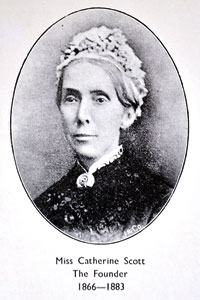 The oldest girls’ school in Colombo marks its 150th anniversary this year
The oldest girls’ school in Colombo marks its 150th anniversary this year
“As far as our Records can tell us the school began away back in 1866 when Miss Scott started a small English school. In those days the whole school met in one rather dark, low-roofed and very bare room – how those early day scholars would stare if they saw our school today….”
-Miss H.M. Park, Principal’s Report 1940
Choate, Park, Scott, Rigby, Restarick, Shire – the six houses to which all Methodist College girls belong are named after the intrepid missionaries who spurred by faith, laboured to build a school in a foreign land. When the Methodist Mission in 19th Century Ceylon began a Sinhala School in the village of Kollupitiya even their faith would not have envisioned a school that proudly bears the Methodist name built not just with bricks and mortar but on solid values, that has stood strong amidst the changing tides in the country and the gusty sea breezes that blow over its home between the seashore and the Galle Road.
As Methodist College marks its 150th anniversary this year, it has the proud distinction of being the oldest girls’ school in Colombo.
It was on November 7, 1866, that Catherine Scott, sister of an English missionary John Scott, known for ‘her gentleness and devotion’ began the Kollupitiya Girls’ English School with just one room and 40 students. The room, the story goes was divided into three and while the students learnt Sinhala and English, John Scott was learning Sinhala in a far corner. After nearly two decades of dedicated service it was as a Grant-in-Aid English High School with 99 students that she left it in 1883 and a new name- the Kollupitiya Girls’ High School.
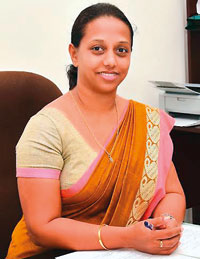
Principal - Mrs. Hiranya Fernando
Other pioneering figures were Miss Choate (Principal from 1894-1905 and 1912-1937) and Miss Park (1939-1943) who having joined as Vice-Principal in 1913 began the teaching of elementary science. In 1915, the school was rechristened Methodist College. The missionaries who followed these pioneers were never slow to break new ground. The school was the first in Colombo to introduce Guiding in 1917. To School Manager Rev. Rigby, goes the credit for the building that came to be known as Rigby Hall as well as a classroom block and it was under Rev. Restarick who followed him as School Manager that the new hostel was declared open in 1922 (the school’s oldest building today). For generations of MC girls, these names are part of their school identity; the passage of time may cloud their memory of fellow students’ names but seldom the faces and houses identified by a strip of colour on the green school tie.
As World War 2 overshadowed the country, it was a Ceylonese who took the helm, Mrs. Gladys Loos (1944-1951), a name beloved of older generations of Metho girls.
Deloraine Brohier, the school’s oldest School Captain recalls vividly the war years when most schools moved out of Colombo but Methodist soldiered on. Deloraine’s father R.L. Brohier, then Assistant Surveyor General insisted the family stay in Colombo. This was the early 1940s and the British Naval Works Office had commandeered part of the school “the whole area behind the church with an ugly barbed wire fence dividing this area from the school”. On May 5, 1942, after the Easter Sunday air raid, when school reopened it was with a mere 29 students. Yet, there was a general resolve among staff and students to help the war effort and under Mrs. Loos, a vegetable garden flourished –“ when the efforts of sweat and toil were rewarded with baskets of fresh bandakas, red onions, brinjals and beans – great was the delight of all”. The produce went to the school boarding and to their respective homes to supplement depleted food stocks.
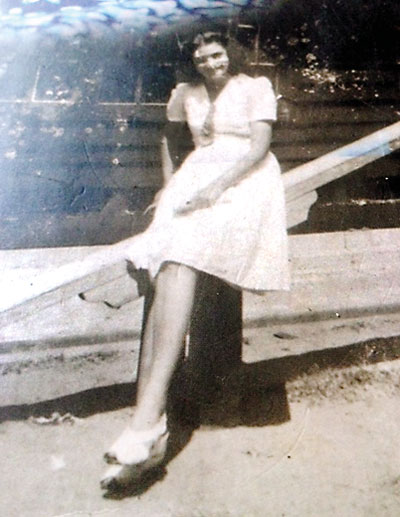
Schooldays: Deloraine Brohier
During air raid drills, when the sirens wailed, they had to dive under their desks and wait in agonised suspense, biting on pencils as instructed till the all –clear was given. Yet school life was happy – Deloraine recalls carefree girls going on bicycling trips around the city and a tour to Ootacamund hill station in south India for the senior girls chaperoned by Mrs Loos – by train to Talaimannar, then the Danushkodi ferry crossing. Captain of Rigby House and then School Captain in 1946, Deloraine believes she was blessed with her parents and far-sighted teachers recognising her talents and leadership qualities.
Wai Tsing Paktsun now Wai Tsing Dias and all of 86 years old was Games Captain of the school in 1949 and before that captain of Restarick House at a time when there were just four houses – Scott, Choate, Rigby and Restarick – Park and Shire being introduced in 1952. All five Paktsun sisters Wai Fun, Wai Fong, Wai Tsing, Wai Ying and Wai Ping went to Methodist and were in the school committee. Wai Tsing herself is a proud second-generation MC-ite and her family now counts four generations in the school.
Miss Shire and Miss Park were at the helm when Wai Tsing joined and she recalls the gentle words of welcome the former spoke to the little five-year-old. Miss Park was more a disciplinarian, “We had to be very neatly dressed,” she laughs, over the phone from Melbourne, Australia. The first Ceylonese Principal was so motherly, the girls fondly called her ‘Mama Loos’ and went to her with all their troubles.
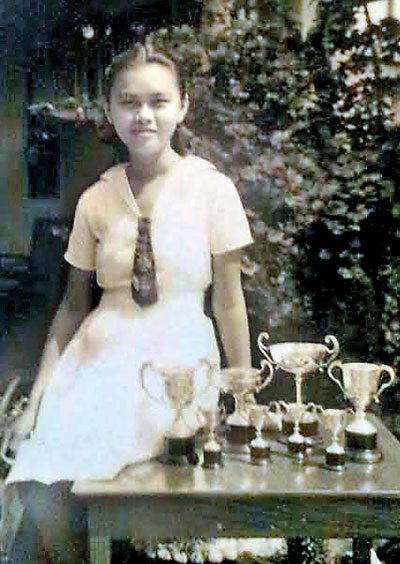
Wai Tsing Paktsun
In Wai Tsing’s day, the school was small, maybe 300-400 students, and there was fellowship, friendship and a sense of belonging to a family, acceptance of one another with no difference of race, caste or creed. Learning the value of discipline, taking responsibility for one’s actions, loyalty and cooperation and above all else, to always do what is right, not what is expedient are the enduring values learnt at MC that have stayed with her throughout her life, she says.
Wai Tsing continued her involvement with the school even after leaving and was among those with Chitra de Alwis, an OGA livewire who organised the first ever MC dance during Miss Robins’ era. Her husband George Dias too contributed immensely serving as President of the School’s Education Society for 20 years.
The school has had long serving principals who have presided over many changes with firm resolve. It was during the era of Miss Grace Robins (1951-1966) that Framjee House on Station Road, Kollupitiya where many bashful youngsters made their first acquaintance with the school was acquired as the nursery and primary. After the school celebrated its centenary, Mrs Shanthi Peiris (1968 -1991) continued the tradition of great principals with major expansion taking place in her time- the Loos block of classrooms opened in 1977 and the Auditorium in 1988 and adjoining hall block of classrooms, also a new four-storeyed building. The school also had several sporting successes – athletics, netball, table tennis and tennis reaching a high.
Mrs. Priyani Fernando was at the helm from 1992-2002, steering the school into the new millennium, with an ambitious programme to expand and refurbish the primary school and the addition of a three-storeyed building with 10 additional classes. Mrs. Fernando had great concern and care for each student in the school and began a wind instrument section in the band as well as a cricket team.
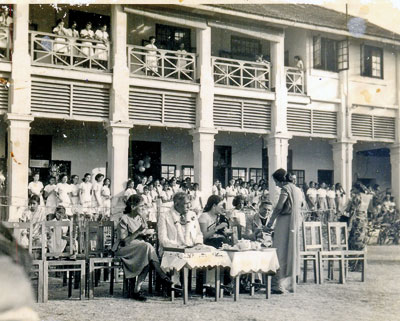 The years of Sri Lanka’s ethnic conflict presented different challenges for Mrs. Shanthi Dias (whom contemporaries will remember as Shanthi Thambar, the gifted concert pianist) who as Principal from 2003 to 2015 during the heightened period of war, shouldered the responsibility of seeing that all students, whatever their ethnicity felt equal and secure in school.
The years of Sri Lanka’s ethnic conflict presented different challenges for Mrs. Shanthi Dias (whom contemporaries will remember as Shanthi Thambar, the gifted concert pianist) who as Principal from 2003 to 2015 during the heightened period of war, shouldered the responsibility of seeing that all students, whatever their ethnicity felt equal and secure in school.
Respect for teachers and respect for rules were integral among students and parents when she was a schoolgirl at MC, and she remembers how Principal Shanthi Peiris moulded her while never teaching her-“just by being who she was- so fair”. In her own time as Principal, Mrs Dias endeavoured to give all students a chance to enjoy the school’s extra-curricular life driven by the belief that “education mustn’t be outside of community”. So it was that in the aftermath of the war, Methodist College held a programme in Kilinochchi for four schools, with permission from the Army. Earlier, tsunami relief programmes also figured large with OGA support with all such programmes organised by the girls giving everyone a chance to be involved. In drama, choir and debating the school achieved noteworthy success and Mrs. Dias takes quiet satisfaction that the debaters, choristers and dancers all had the chance to travel abroad to take part in international events. As Principal she instituted a fund for overseas training of staff in memory of Mrs Peiris and began an educational support unit for children who learn differently.

Picture from the past: Filing in for assembly
Taking over in the school’s landmark 150th year is Mrs. Hiranya Fernando, who has been nurtured in the Methodist College values all her life. Co-Vice Principal since 2013, she is the fifth generation in her family at MC. Her great-great grandmother Mary L. Perera was at the school in the late 19th Century (the family has a Bible she had received as a special prize from Girls’ High School, Kollupitiya dated 1888) and her great grandmother Daisy Jayawardena (later Jayasekera), a brilliant scholar also attended Methodist (along with all her six sisters in the hostel). So too her grandmother Joan de Alwis and mother Damaris de Alwis Wickremesekera, who was head girl in 1968. Hiranya joined Methodist in 1984 during Mrs. Shanthi Peiris’s era and has vivid memories of the model of meticulous precision she imparted.
As Principal now, her vision is crystal clear. “One of the things that was impressed on me when I was in school was this idea of service. It was instilled in me that every act you do it should be done as an act of service. Any job you are doing, you do it with that spirit,” she says, adding that she sees her role now in the same way. In this increasingly competitive world, this is an important lesson for her young charges- that it’s not about winning or conquering, rather doing whatever needs to be done to the best of your ability and that, that in itself should be the reward.
As teachers, it’s all about validating the child, she stresses. The school’s responsibility is bringing up good citizens, good women for this country who will fill gaps that other people are not interested in looking at. Maintaining a high standard of education, yet having it accessible to middle-income parents, the school has always had funds for sponsorship of needy children.
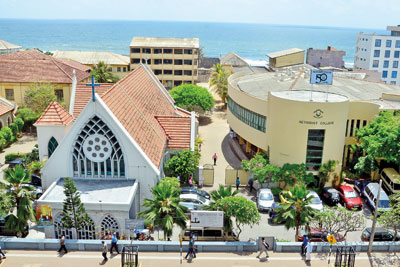
A bird’s eye view: Methodist College, Kollupitiya, extending from the Galle Road down to the sea. Pic by Indika Handuwala
New issues confront her every day, increasing societal and family pressure on children and technology sometimes proving a threat. The latter is an integral part of a child’s life in the modern world and she sees the challenges as two-fold: using it effectively in the classroom, moving on from strictly textbook teaching, while also making children aware of the pitfalls of social media, to use it wisely within a certain framework. “I think we need to do more to make them aware of the dangers,” she says frankly.
Moving with the times, London A’L classes were begun in 2015 and this year for post O’L students, idly waiting for results, the school ran courses on human resource management, accountancy (AAT), and aviation, the latter in conjunction with the SriLankan Aviation College. “The children were thrilled,” Mrs. Fernando says, adding that in its wake an aeronautical club has been set up – no limits to how high the girls can fly.
The Methodist Church manages the school as it always has but Methodist College since 2014 is a fully private school (earlier it was a Government Assisted School). Though Christians make up around two-thirds of the student strength of 1,875, MC has always embraced students of all faiths and ethnicities. Buddhist, Hindu and Muslim activities figure in the school calendar and even under colonial rule, the Methodist College magazine had sections in Sinhala and Tamil and active Sinhala and Tamil literary and drama societies.
The 150th year has been hectic, with anniversary events intermingled with regular school events. Past Games Captains joined in the sports meet in February, young and not so young walked oblivious to the rain in the MC Walk in May and a choir concert “Resonance’ saw joyous music fill the Lionel Wendt in June. Still ahead this month, the OGA dance and ‘Nethranjali’ a Kandyan and Bharatha Natyam dance recital – symbolising as the Principal says the unity among all communities that has always been a hallmark of this school, very grounded in the culture of the land.
On November 7th, the schoolgirls will have a special assembly and on the 12th, a 150th anniversary gala dinner will wrap up a memorable year. And even if not present at the celebrations, MC girls near and far, will no doubt, offer heartfelt thanks for their beloved school, inspirational teachers and classmates turned lifelong friends, echoing perhaps the words of the school hymn they know so well -“Praise my soul, the King of Heaven, to His feet, thy tribute bring…”
Helen Park’s message for the school’s centenary holds true today as Methodist College celebrates its 150th year: “How my heart goes out in greetings to you all, old and young. May the coming years be rich and even richer in fuller and wider service to the Island we all love so well….”
-Renuka Sadanandan
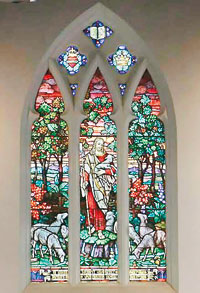 Gazing at the stained glass window Gazing at the stained glass windowThe Kollupitiya Methodist Church is very much a part of school life at MC– Tuesday to Fridays, the day begins with prayers ( on Mondays, it’s Assembly in the hall). Generations of schoolgirls have gazed at the beautiful stained glass window behind the church altar – of Christ, the Good Shepherd, even their youthful restlessness stilled by the radiance of light that illuminates the stained glass. It has always been so. In the school magazine of November 1937, is a poem by M.E.S. titled ‘The stained glass window’, the first verse of which is given here.‘Tis the hour of worship, and all is hush’d But human hearts within are toss’d By frenzied prayers or selfish pride And the preacher’s voice is vainly lost In the inward clamour that will not bide From these to the Window I lift my eyes, The golden sunlight streaming through- Peace, peace, my heart God speaks in the beauty of art’ | |


